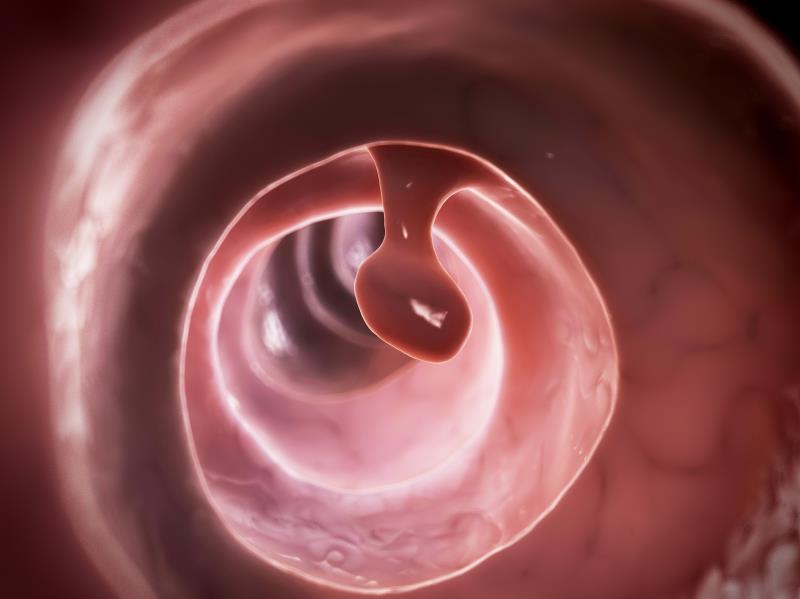
Patients with any subtypes of polyps had a greater risk of developing colorectal cancer (CRC) than the general population in a largely screening-naive Swedish cohort, indicating that CRC risk is not limited to just those with advanced histology, reveals a large registry-based study.
Noneheless, only three of the more advanced subtypes —tubulovillous adenomas, villous adenomas, and sessile serrated polyps — were associated with increased risk of death from CRC.
“Our findings suggest that patients with any of the latter three lesions might benefit from colonoscopy surveillance,” the researchers said.
In the prospective nationwide ESPRESSO* cohort study, 178,377 patients with colorectal polyps were matched to 864,831 reference individuals by age, sex, birth year, year of biopsy, and residency county. [Lancet Gastroenterol Hepatol 2020;doi:10.1016/S2468-1253(20)30009-1]
At 10 years, the cumulative CRC incidence was 1.6 percent for hyperplastic polyps, 2.5 percent for sessile serrated polyps, 2.7 percent for tubular adenomas, 5.1 percent for tubulovillous adenomas, and 8.6 percent for villous adenomas, compared with 2.1 percent in the reference cohort.
After adjusting for potential confounders, all subtypes of polyps were positively associated with CRC incidence, with increasing risk for more advanced histology: the hazard ratio (HR) was 1.11 for hyperplastic polyps (p=0.02), 1.41 for tubular adenomas (p<0.0001), 1.77 for sessile serrated polyps (p<0.0001), 2.56 for tubulovillous adenomas (p<0.0001), and 3.82 (p<0.0001) for villous adenomas.
For CRC mortality, only sessile serrated polyps (HR, 1.74; p=0.02), tubulovillous adenomas (HR, 1.95; p<0.0001), and villous adenomas (HR, 3.45; p<0.0001) showed positive associations, but not tubular adenomas (HR, 0.9; p=0.63) or hyperplastic polyps (HR, 0.90; p=0.20).
“The risk of both CRC incidence and mortality increased by advanced [polyp] histology, … whereas the time interval between polyp diagnosis and subsequent CRC diagnosis decreased by advanced histology,” the researchers observed.
“Moreover, patients with hyperplastic polyps and sessile serrated polyps were more likely to develop proximal colon cancer than those with some conventional adenomas,” they noted.
However, the researchers believed that the higher incidence of proximal cancer with hyperplastic polyps might be attributed to misclassification of sessile serrated polyps, especially during the early years when the sessile serrated histology was not commonly recognized.
“Given the subtle endoscopic appearance, sessile serrated polyps are more likely to be missed and incompletely removed than are conventional adenomas. Also, the molecular features of sessile serrated polyps (eg, BRAF mutation) might induce more rapid malignant transformation,” explained the researchers on the increased mortality risk seen with sessile serrated polyps.
Moving forward
“[Understanding] CRC incidence and mortality in relation to different histological subtypes of polyps … [is important] to improve the current colonoscopy surveillance guidelines for better prevention of CRC,”
“The fact that more than one in 15 patients developed CRC within 3 years raises the question whether this interval [of surveillance] should be shortened for villous adenomas specifically,” wrote Drs Reinier Meester and Uri Ladabaum of Erasmus University Medical Center in Rotterdam, the Netherlands, and Stanford University in Stanford, California, US, respectively, in a commentary. [Lancet Gastroenterol Hepatol 2020;doi:10.1016/S2468-1253(20)30074-1]
Noting the lack of data on other factors that might influence CRC risk, such as polyp size and lifestyle, they suggested future studies should clarify how best to survey patients and CRC risk after after polyp removal.
“Although some polyp types were associated with higher risk than others, no patient groups had risks lower than the general population. This finding should prompt us to ask why polyp removal did not decrease the risk to below general population risk, and whether improved inspection, detection, and resection methods [help],” noted Meester and Ladabaum.